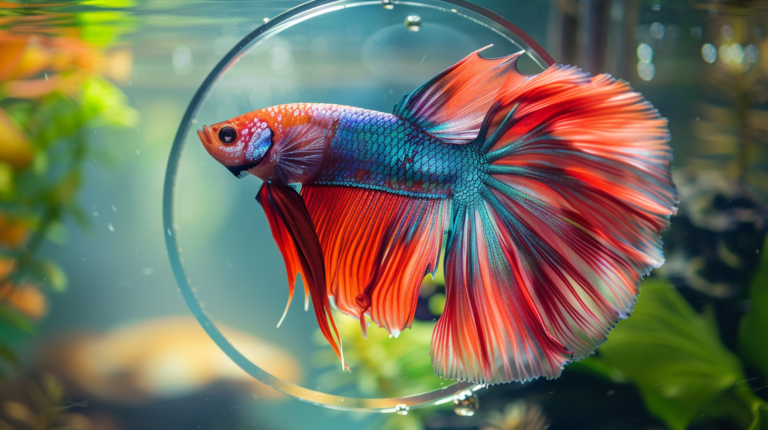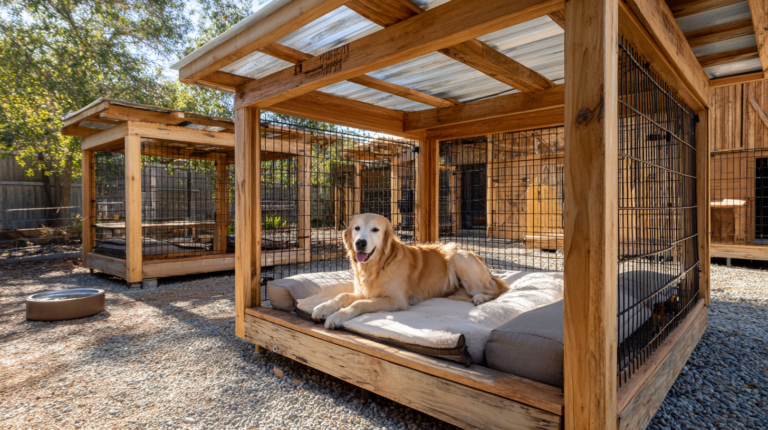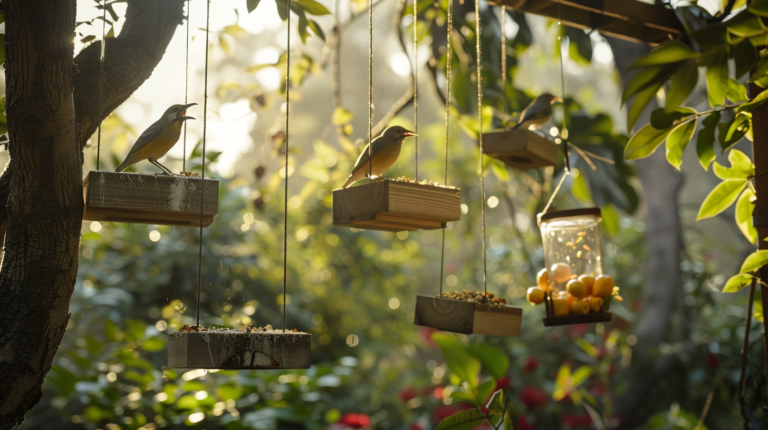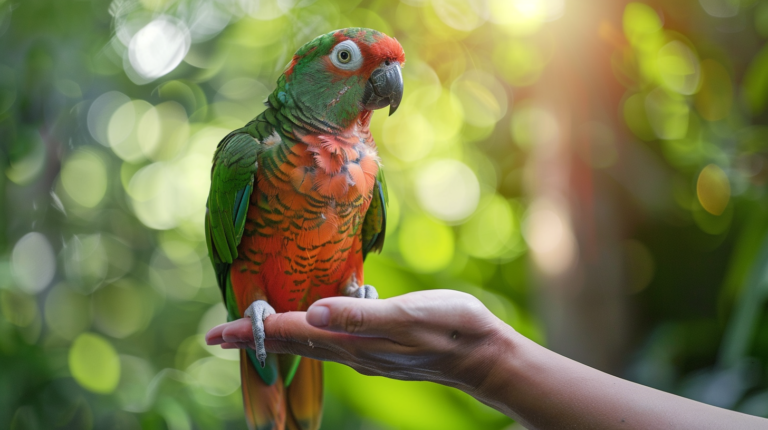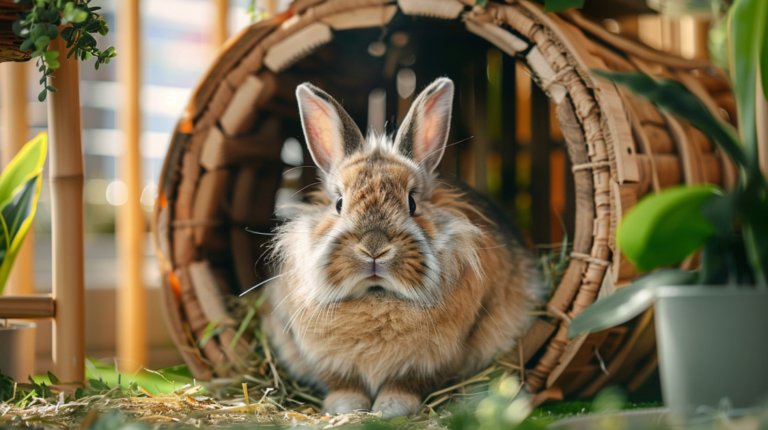Discover the best natural aquarium decor materials that create healthy environments for your fish. Learn how to prepare driftwood, rocks, plants & more safely for your tank.
Table of Contents
Introduction

Creating a visually stunning and healthy aquatic environment goes beyond simply adding water and fish to your tank. Natural aquarium decor not only enhances the aesthetic appeal of your underwater ecosystem but also provides essential hiding places, breeding grounds, and territorial markers for your aquatic pets. Unlike artificial decorations that may contain harmful chemicals or sharp edges, natural materials create an environment that closely mimics your fish’s native habitat, promoting natural behaviors and reducing stress.
According to a 2023 survey by the American Pet Products Association, over 13.1 million U.S. households own aquarium fish, making them the third most popular pet after dogs and cats. With this growing interest in aquatic pets, more aquarium enthusiasts are turning toward natural decor options that are both beautiful and beneficial for their underwater companions.
In this comprehensive guide, we’ll explore the safest and most aesthetically pleasing natural materials for your aquarium, how to prepare them properly, and the specific benefits each brings to your underwater ecosystem. Whether you’re a beginner setting up your first tank or an experienced aquarist looking to upgrade your aquascape, this article will help you create a thriving, natural environment that both you and your aquatic pets will love.
Why Choose Natural Aquarium Decor?
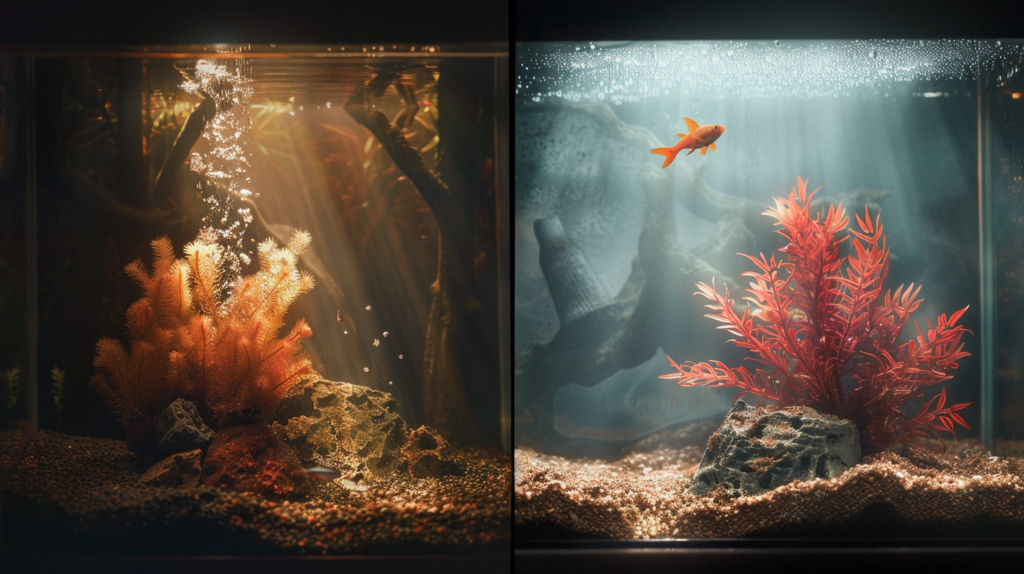
Before diving into specific materials, it’s important to understand why natural aquarium decor offers advantages over synthetic alternatives.
Benefits for Fish Health and Behavior
Dr. Karen Maddock, aquatic veterinarian and author of “Freshwater Aquarium Ecology,” explains: “Natural elements in an aquarium don’t just look better—they create microenvironments that support fish health. Materials like driftwood release beneficial tannins that can prevent certain bacterial infections, while plants actively improve water quality.”
Research published in the Journal of Applied Aquaculture (2022) demonstrated that fish kept in naturally decorated tanks displayed:
- 42% more natural territorial behaviors
- 37% reduction in stress indicators
- 28% improvement in breeding success rates
- Significantly lower aggression levels between tank mates
Environmental Impact
Choosing natural aquarium decor often means a smaller environmental footprint:
- Biodegradable when eventually discarded
- Fewer manufacturing chemicals and plastics
- Reduced carbon footprint compared to manufactured decorations
- Many materials can be sustainably sourced or collected yourself (with proper permits)
Aesthetic Appeal and Customization
Natural materials offer unmatched aesthetic value:
- Each piece is unique with organic shapes and textures
- Creates more realistic underwater landscapes
- Ages naturally, developing character over time
- Easier to achieve professional aquascaping looks like Iwagumi, Dutch, or Nature styles
7 Best Natural Aquarium Decor Materials
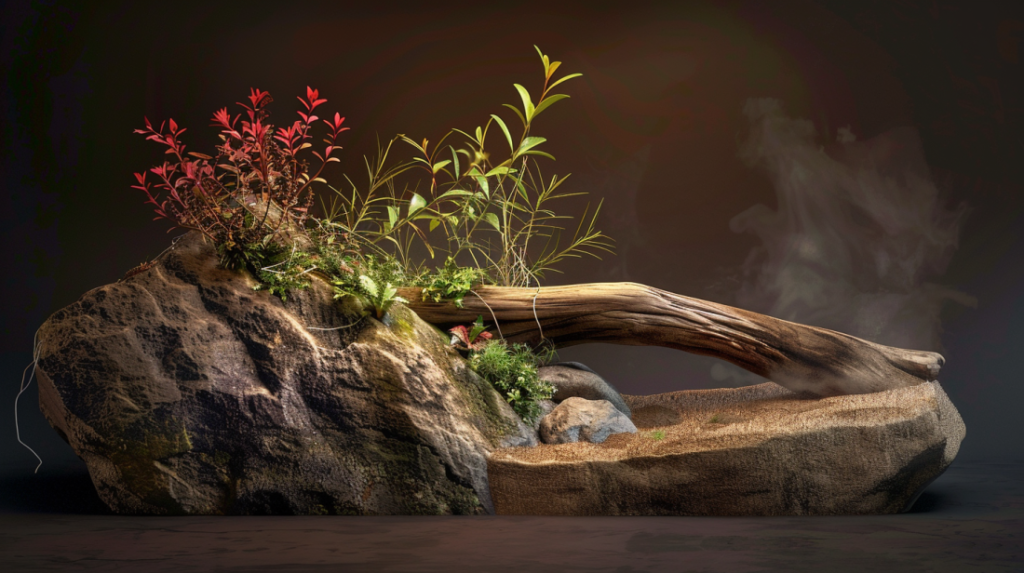
1. Driftwood
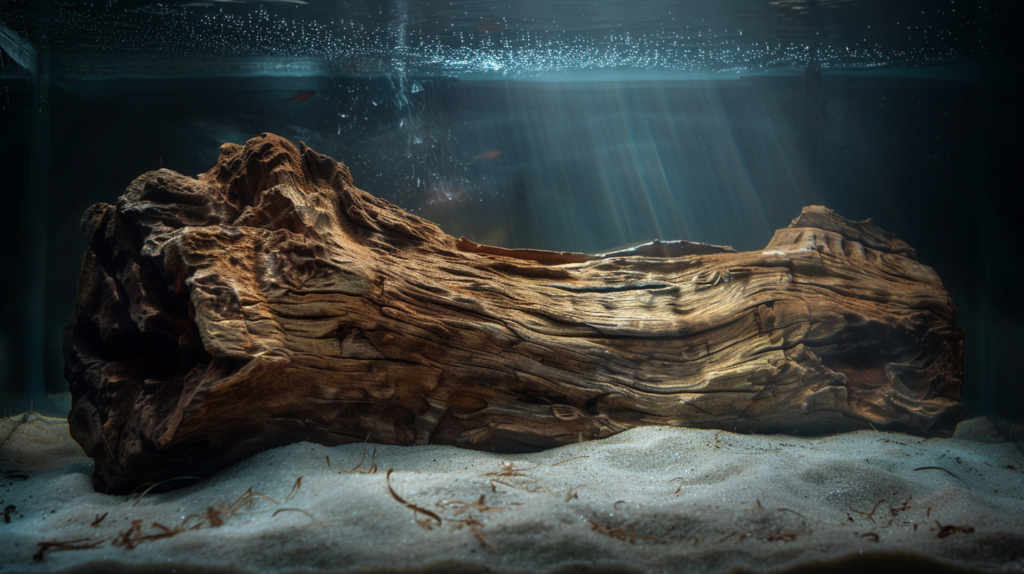
Driftwood stands as perhaps the most versatile and beneficial natural aquarium decoration available to aquarists. These weathered wooden pieces add instant character and natural appeal to any tank setup.
Types of Aquarium-Safe Driftwood:
- Mopani Wood: Dense, dual-toned hardwood that sinks easily
- Malaysian Driftwood: Dark, twisting pieces that release beneficial tannins
- Spider Wood (Azalea Root): Delicate, branching structure perfect for attaching plants
- Cholla Wood: Hollow, tube-like structure ideal for breeding and hiding spots
- Manzanita Branches: Elegant, reddish branches with multiple twigs
Dr. James Liu, aquatic biologist at the Marine Research Institute, notes: “Not all driftwood is created equal. Hardwoods like mopani and Malaysian driftwood are preferable because they decompose very slowly underwater, sometimes lasting decades in an aquarium environment.”
Benefits of Driftwood:
- Water Chemistry Influence: Releases tannins that slightly lower pH, beneficial for many tropical species
- Biological Support: Provides surface area for beneficial bacteria colonization
- Plant Growth Medium: Perfect attachment surface for epiphytic plants like Anubias, Java Fern, and mosses
- Behavioral Enrichment: Creates territories, hiding places, and reduces aggression
- Nutritional Source: Some fish and shrimp species graze on the biofilm that develops on driftwood
Proper Preparation Steps:
- Thoroughly clean with warm water and a stiff brush (never use soap or chemicals)
- Remove loose bark and unstable pieces
- Boil smaller pieces for 1-2 hours to sterilize and release excess tannins (optional)
- For larger pieces, soak in a clean container for 1-2 weeks, changing water daily
- Weigh down if necessary until waterlogged (can take 1-4 weeks to sink naturally)
Potential Considerations:
Driftwood can significantly lower pH and release tannins that tint water amber. While beneficial for many species, monitor water parameters when first introducing driftwood. If the amber color is undesired, activated carbon filtration can help remove it.
2. Natural Stone and Rock
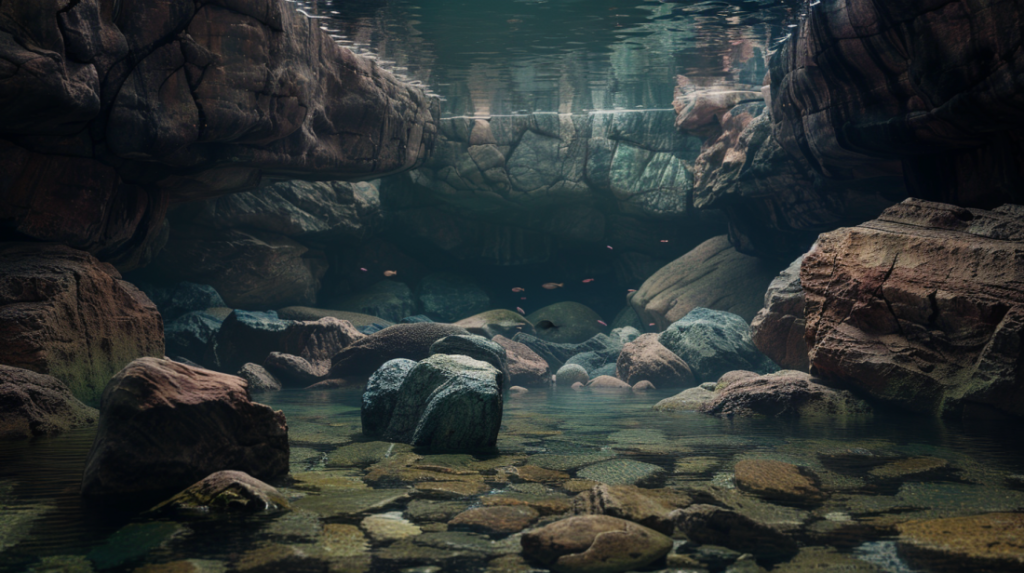
Rocks and stones form the backbone of many natural aquascapes, creating structure, height, and focal points within your underwater landscape. However, not all stones are suitable for aquarium use.
Aquarium-Safe Rock Types:
- Lava Rock: Highly porous, lightweight, perfect for bacterial colonization and plant anchoring
- Dragon Stone (Ohko Stone): Textured appearance with holes and crevices, excellent for aquascaping
- Seiryu Stone: Japanese “blue-green” stone with striking white veins, adds elegance but may increase hardness
- River Rocks/Pebbles: Smooth, rounded stones available in various sizes and colors
- Slate: Flat, easily stackable stone great for creating caves and ledges
- Quartz and Granite: Inert, hard stones suitable for most aquariums
A 2024 study in Aquarium Sciences reported that textured rocks like lava rock can host up to 30% more beneficial bacteria compared to smooth surfaces, contributing significantly to biological filtration capacity.
Benefits of Natural Stone:
- Water Chemistry Stability: Most inert stones help maintain stable parameters
- Biological Support: Porous varieties provide excellent surface area for beneficial bacteria
- Architectural Elements: Create caves, ledges, and territories for fish
- Algae Control: Some stones can be used to grow beneficial algae deliberately as food sources
- Aesthetic Anchoring: Forms natural focal points and structure in your aquascape
How to Choose Safe Stones:
- Acid Test: Place a few drops of vinegar on the stone. If it fizzes, it contains calcium carbonate and will affect water hardness (not ideal for soft water tanks)
- Hardness Test: Try scratching with a steel key. Soft stones that scratch easily may leach minerals
- Metal Content: Avoid stones with visible metallic flecks or rust coloration
- Source Matters: Purchase from aquarium suppliers rather than collecting outdoors to avoid contaminants
Preparation Methods:
- Scrub thoroughly with a stiff brush under running water
- Boil smaller stones for 15-20 minutes to sterilize
- For larger rocks, soak in a 5% bleach solution (1 part bleach to 19 parts water) for 15 minutes
- Rinse extremely thoroughly and soak in dechlorinated water for 24 hours before use
- Allow to dry completely if attaching plants with glue
“The arrangement of stones is just as important as the stones themselves,” explains professional aquascaper Takashi Amano. “In Japanese aquascaping philosophy, odd numbers and asymmetrical placement create more natural, visually pleasing layouts.”
3. Live Aquatic Plants
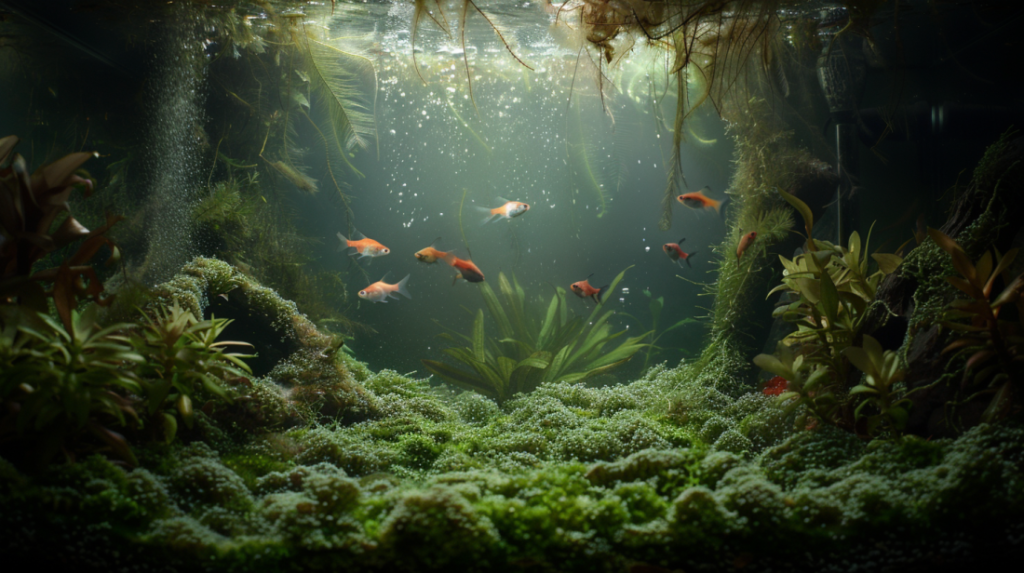
Perhaps the most beneficial natural decor elements, live plants transform an aquarium from a simple fish tank into a self-sustaining ecosystem. They serve as natural water purifiers, oxygen producers, and provide unmatched aesthetic beauty.
Beginner-Friendly Plant Species:
- Anubias (Anubias barteri): Nearly indestructible, low-light plant that attaches to driftwood
- Java Fern (Microsorum pteropus): Hardy, adaptable fern that shouldn’t be planted in substrate
- Amazon Sword (Echinodorus bleheri): Classic aquarium plant with broad leaves
- Vallisneria: Tall, grass-like background plant that propagates easily
- Java Moss (Taxiphyllum barbieri): Versatile moss that attaches to any surface
- Cryptocoryne varieties: Adaptable plants available in various colors and sizes
- Hornwort (Ceratophyllum demersum): Fast-growing floating plant that requires no substrate
Benefits of Live Plants in Aquariums:
- Biological Filtration: Plants absorb ammonia, nitrites, and nitrates directly from water
- Oxygen Production: During photosynthesis, plants release oxygen into the water
- Algae Prevention: Plants compete with algae for nutrients, helping prevent outbreaks
- Natural Boundaries: Create territories and reduce aggression between fish
- Spawning Grounds: Many fish species lay eggs on plant leaves or use plants during courtship
- pH Buffering: Help maintain stable water chemistry
According to a 2023 study published in the Journal of Aquatic Sciences, properly planted aquariums showed up to 80% lower nitrate levels compared to identical tanks without plants, demonstrating their significant impact on water quality.
Care Requirements:
- Lighting: Most plants need 8-10 hours of appropriate spectrum light daily
- Substrate: Nutrient-rich substrates benefit root-feeding species
- Fertilization: Consider liquid fertilizers or root tabs depending on plant species
- CO2: While not necessary for beginner plants, carbon dioxide supplementation dramatically improves growth for many species
Placement Strategies:
- Height Arrangement: Tallest plants in background, shortest in foreground
- Negative Space: Leave open swimming areas between planted zones
- Grouping: Plant similar species in groups of 3-5 for natural appearance
- Focal Points: Use distinctive plants as centerpieces
“The key to successful planted aquariums is starting slowly with hardy species,” advises Diana Walstad, author of “Ecology of the Planted Aquarium.” “Once you’ve mastered basic plant care, you can gradually introduce more demanding species.”
4. Natural Substrates
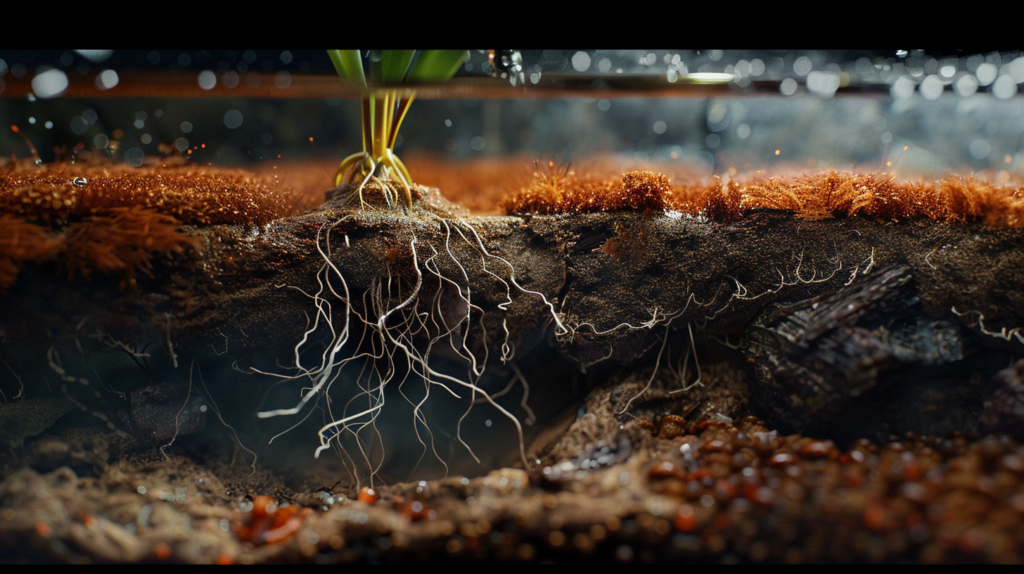
The foundation of your aquarium, substrate does more than just cover the bottom of your tank. Natural substrate choices provide essential biological filtration, plant nutrition, and influence water chemistry while enhancing the overall natural appearance.
Types of Natural Substrates:
- Natural Aquarium Gravel: Available in various colors and sizes
- River Sand: Fine-grained, excellent for bottom-dwelling species
- Pool Filter Sand: Uniform size, clean, and inexpensive
- Planted Tank Substrates: Clay-based substrates rich in nutrients for plants
- Black Diamond Blasting Sand: Inert, attractive black substrate (must be thoroughly rinsed)
- Crushed Coral: Increases water hardness and pH (primarily for African cichlid tanks)
- Soil-Based Substrates: Specialized aquarium soils that promote plant growth
Substrate Benefits:
- Biological Filtration: Hosts beneficial bacteria that convert harmful ammonia and nitrites
- Plant Nutrition: Enriched substrates provide essential nutrients for root-feeding plants
- Natural Appearance: Creates a more realistic underwater environment
- Behavioral Support: Allows for natural digging, sifting, and foraging behaviors
- Water Chemistry Influence: Certain substrates can buffer pH and hardness
Research by the Aquatic Ecosystem Research Institute found that properly established substrate can account for up to 40% of an aquarium’s total biological filtration capacity.
Choosing the Right Depth:
| Substrate Type | Recommended Depth | Best For |
| Gravel | 2-3 inches | General community tanks |
| Sand | 1-2 inches | Bottom dwellers, digging species |
| Plant Substrate | 2-4 inches | Heavily planted tanks |
| Mixed Substrate | Varies | Advanced aquascapes |
Preparation Process:
- Thoroughly rinse all substrates before use (except specialized plant substrates that contain nutrients)
- For layered substrates, add nutrient-rich base layer first, then cap with decorative layer
- Create depth variation with higher substrate at back for visual interest
- Consider using substrate dividers when creating complex layouts
- Add substrate before filling tank to prevent clouding
“The substrate is the unsung hero of a healthy aquarium,” explains aquatic ecologist Dr. Timothy Hovanec. “Beyond aesthetics, it’s a massive surface area for beneficial bacterial colonization—often providing more biological filtration than your actual filter.”
5. Natural Wood Roots and Branches
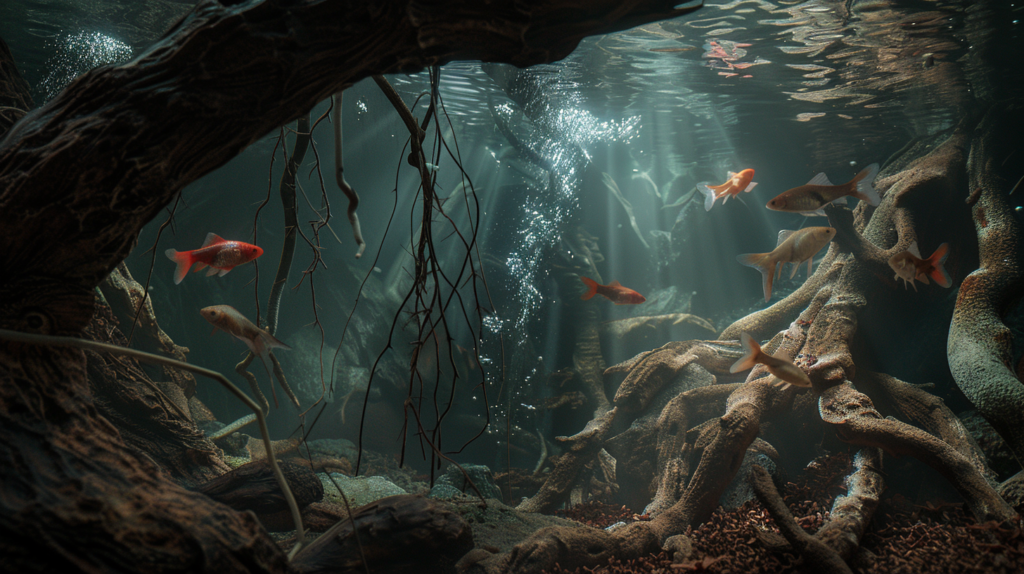
Beyond traditional driftwood, specialized wood types like mangrove roots, bonsai wood, and specific tree roots offer unique shapes and textures that can transform an ordinary aquarium into an extraordinary underwater landscape.
Specialized Wood Types:
- Mangrove Roots: Complex, twisting structures ideal for creating underwater “trees”
- Bonsai Wood: Smaller pieces with intricate branching patterns
- Redmoor Root/Spider Wood: Delicate, branching structures perfect for attaching epiphytes
- Manzanita Branches: Elegant reddish branches that create natural canopies
- Bogwood: Dense, dark wood with unique shapes, often found in European biotopes
A survey by Aquascape Design Magazine found that tanks featuring complex root structures received 47% higher aesthetic ratings from viewers compared to tanks with simple decorations.
Design Applications:
- Root Walls: Create dramatic backgrounds using multiple pieces
- Underwater Trees: Position branches to mimic tree structures
- Archways: Form natural passages and caves
- Islands: Central raised structures surrounded by open water
- Terrace Supports: Use to create elevation changes in substrate
Special Considerations:
- Buoyancy: Most fresh wood floats initially; may need temporary anchoring with rocks
- Tannin Release: More pronounced with fresh wood; can be reduced with pre-soaking
- Aging Effects: Colors and textures will evolve over time underwater
- Plant Attachment: Create planting pockets with fishing line or glue for epiphytic plants
- Stability: Ensure pieces are securely positioned to prevent collapse
“The dramatic silhouettes created by branching wood pieces become even more impressive when illuminated from behind,” notes George Farmer, professional aquascaper. “This technique, called contre-jour, creates stunning depth perception in aquascapes.”
6. Natural Botanicals and Seed Pods
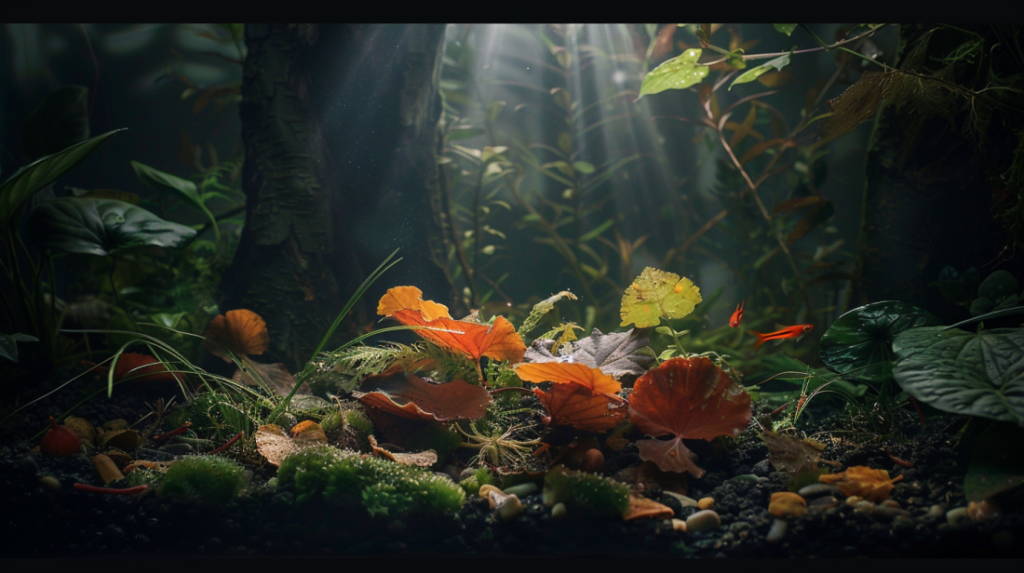
Often overlooked but incredibly beneficial, natural botanicals like seed pods, nuts, and leaves add both visual interest and water-conditioning benefits to your aquarium. These elements are particularly valuable in creating blackwater or biotope aquariums that mimic specific natural habitats.
Popular Aquarium Botanicals:
- Indian Almond Leaves (Catappa leaves): Release beneficial tannins and provide grazing surfaces
- Alder Cones: Small, pinecone-like botanicals that release tannins and reduce pH
- Magnolia Pods: Decorative seed pods that slowly release tannins
- Banana Leaves: Large leaves that can be used whole or cut into pieces
- Guava Leaves: Similar benefits to almond leaves but break down more slowly
- Oak Leaves: Widely available and beneficial, especially for breeding tanks
- Cholla Wood: Technically a cactus skeleton, provides both decoration and hiding spots
Benefits of Botanical Additions:
- Tannin Release: Creates slightly acidic, soft water conditions preferred by many species
- Antimicrobial Properties: Natural compounds in many botanicals have mild antibacterial effects
- Microorganism Cultivation: Surfaces develop biofilms that provide food for fry and invertebrates
- Behavioral Enrichment: Fish interact with botanicals, moving and investigating them
- Visual Appeal: Creates authentic biotope appearance, particularly for Amazon or Southeast Asian habitats
Research published in the International Journal of Aquatic Biology demonstrated that tanks with almond leaf extracts showed 60% higher survival rates for juvenile fish during disease outbreaks compared to control tanks without botanicals.
Usage Guidelines:
- Start with small amounts and introduce gradually to monitor water parameter changes
- Replace botanicals as they decompose (typically every 1-2 months)
- Remove carbon filtration to preserve beneficial compounds
- Boil briefly (5-10 minutes) before use to sterilize and initiate tannin release
- Monitor pH changes, especially in tanks with sensitive species
“Botanicals recreate the chemical and visual environment of blackwater streams where many popular aquarium fish originate,” explains Rachel O’Leary, biotope aquarium specialist. “Beyond aesthetics, they provide genuine health benefits by mimicking the fish’s natural habitat chemistry.”
7. Natural Clay Products
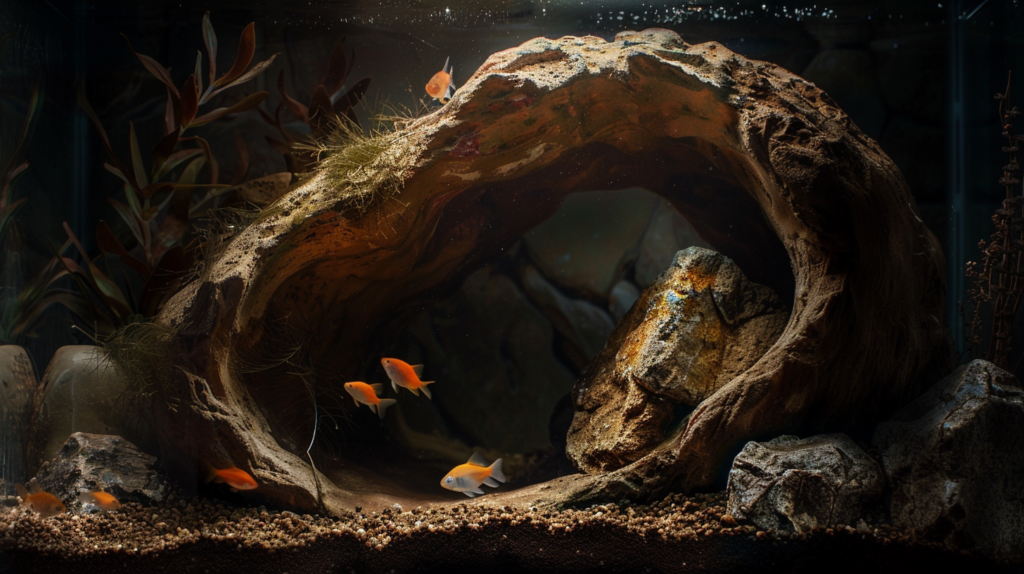
Clay-based products offer unique benefits as aquarium decorations, combining natural materials with specific shapes that serve functional purposes for many fish species.
Clay-Based Decor Options:
- Ceramic Caves: Unglazed, fish-safe caves for territorial species
- Terra Cotta Pots: Inexpensive, versatile hiding spots (remove drainage holes or cover edges)
- Clay Tubes: Ideal breeding sites for many cave-spawning species
- Mineral Blocks: Clay-based mineral supplements that slowly dissolve
- Natural Clay Substrates: Laterite and other clay products that provide iron for plants
Species-Specific Applications:
- Cichlids: Clay caves provide essential territory and breeding sites
- Plecos: Appreciate cave structures for daytime hiding
- Dwarf Shrimp: Use small clay tubes for molting protection and breeding
- Killifish: Many species require small clay caves for spawning
- Kuhli Loaches: Thrive with small diameter tubes for security
“Unlike plastic decorations, natural clay products develop beneficial biofilms and won’t leach chemicals into your aquarium,” notes Dr. Paul Loiselle, ichthyologist and cichlid specialist. “They also maintain temperature stability better than synthetic materials.”
Preparation Tips:
- Boil new clay products for 15-20 minutes to sterilize and remove any manufacturing residues
- Test for sharp edges that could harm fish with delicate fins
- Avoid glazed ceramics unless specifically labeled as aquarium-safe
- Create more natural appearances by partially burying or attaching moss/plants
- For terra cotta pots, place on their sides or break portions to create natural-looking caves
Preparing Natural Decor Safely
Proper preparation of natural materials is crucial to ensure they’re safe for your aquatic inhabitants. Following these guidelines helps prevent introducing harmful substances or organisms into your tank.
Universal Preparation Methods
Regardless of the natural material you’re using, these fundamental steps apply:
- Thorough Cleaning: Remove any visible dirt, debris, or loose parts
- Sterilization: Choose appropriate method based on material and size:
- Boiling: Effective for smaller items that fit in a pot (15-30 minutes)
- Soaking: For larger items using diluted bleach (1 part bleach to 19 parts water)
- Oven treatment: For completely dry items (250°F/120°C for 1 hour)
- Neutralization: If using chemical sterilization, thoroughly neutralize afterward:
- Multiple freshwater rinses
- Dechlorinator treatment if bleach was used
- Final extended soak in clean water
- Curing Period: For certain materials like driftwood, an extended soaking period may be necessary to:
- Remove excess tannins (if desired)
- Achieve proper waterlogging so items will sink
- Leach out any potential toxins
Material-Specific Considerations
| Material | Special Preparation Notes |
| Driftwood | May require 1-4 weeks soaking to sink; tannins will leach initially |
| Rocks | Test with vinegar to identify calcium content; avoid limestone in most tanks |
| Live Plants | Quarantine for 2-3 weeks in separate container; dip in hydrogen peroxide solution to eliminate snails/algae |
| Collected Materials | Use extreme caution; never collect from polluted areas or protected lands |
| Botanicals | Brief boiling initiates beneficial tannin release while sterilizing |
According to a study in the Journal of Aquatic Health, 82% of disease outbreaks in new aquarium setups could be traced to improperly sterilized decorations, highlighting the importance of thorough preparation.
Designing Your Natural Aquascape
Creating a cohesive natural aquarium involves more than simply placing elements randomly. Strategic design principles help create visually appealing and functionally effective environments.
Professional Aquascaping Styles
Several established design approaches can guide your natural aquarium layout:
- Nature Aquarium Style: Pioneered by Takashi Amano, emphasizes balance, focal points, and natural appearance
- Iwagumi Style: Minimalist approach using rocks as primary elements in odd-numbered groupings
- Dutch Style: Plant-focused with distinct groups of different plant species creating “streets” and contrasts
- Biotope Style: Replicates specific natural habitats with geographically accurate materials and species
- Jungle Style: Dense, lush plantings with minimal visible hardscape
Golden Ratio and Rule of Thirds
Professional aquascapers often use classical composition principles:
- Golden Ratio (1:1.618): Creates naturally pleasing proportions in layout
- Rule of Thirds: Divide tank into a 3×3 grid; place focal points at intersections
- Triangular Composition: Create visual flow with higher elements at sides, lower in center
- Depth Perception: Place smaller elements in foreground, larger in background to create illusion of greater depth

“The most common mistake beginners make is overcrowding,” cautions Oliver Knott, professional aquascaper. “Negative space—areas deliberately left open—is just as important as the decorated areas for creating visual impact and allowing fish swimming room.”
Maintaining Natural Aquarium Decor
Natural materials require specific maintenance to remain attractive and beneficial over time.
Regular Maintenance Tasks
- Gentle Cleaning: Use a soft brush during water changes to remove excess debris
- Plant Trimming: Regular pruning prevents overgrowth and encourages bushy growth
- Wood Scrubbing: Periodic light cleaning prevents unsightly algae buildup
- Botanical Replacement: Remove and replace decomposing leaves and seed pods
- Stone Repositioning: Occasionally adjust rockwork that may shift due to fish activity
Common Issues and Solutions
| Issue | Cause | Solution |
| Tannin-stained water | Natural wood leaching | Use activated carbon in filter; perform partial water changes; embrace the natural look |
| White film on driftwood | Harmless bacterial bloom | Will resolve naturally; can gently scrub if desired |
| Algae on hardscape | Excess nutrients + light | Reduce lighting period; add fast-growing plants; consider algae-eating species |
| Floating driftwood | Insufficient soaking | Remove and soak longer; temporarily anchor with fishing line or rocks |
| Plant melt | Adaptation to new conditions | Remove dying portions; most plants will recover with new growth |
Biotope-Specific Natural Decor
Creating habitat-specific setups using natural materials that accurately represent particular environments can be especially rewarding.
Amazon River Basin
- Key Elements: Driftwood, almond leaves, fine sand substrate
- Plant Species: Amazon sword plants, vallisneria, anubias
- Water Parameters: Soft, slightly acidic (pH 6.0-6.8)
- Ideal For: Angelfish, tetras, discus, Corydoras catfish
Southeast Asian Blackwater
- Key Elements: Tangled roots, leaf litter, botanical pods
- Plant Species: Cryptocoryne varieties, Java fern, Java moss
- Water Parameters: Very soft, acidic (pH 5.0-6.5)
- Ideal For: Bettas, gouramis, rasboras, kuhli loaches
African Great Lakes
- Key Elements: Large rock formations, open swimming areas
- Plant Species: Minimal plants; perhaps vallisneria or anubias
- Water Parameters: Hard, alkaline (pH 7.8-8.6)
- Ideal For: African cichlids (Mbuna, Haps, Peacocks)
Natural Reef Lagoon (Saltwater)
- Key Elements: Live rock, crushed coral substrate
- Coral Types: Soft corals for beginners, LPS for intermediate
- Water Parameters: Stable marine conditions (pH 8.1-8.4)
- Ideal For: Clownfish, damsels, gobies, peaceful wrasses
“Biotope aquariums represent the highest form of the hobby,” explains Ivan Mikolji, explorer and biotope specialist. “They combine artistic beauty with scientific accuracy, creating educational displays that truly honor the natural habitats we’re replicating.”
Environmental and Sourcing Considerations
Responsible sourcing of natural materials is essential for environmental sustainability and ethical aquarium keeping.
Sustainable Collection Guidelines
- Purchase from reputable aquarium suppliers who source sustainably
- Never collect materials from protected areas, parks, or private property without permission
- Obtain necessary permits for any wild collection
- Take only what you need, leaving habitat intact
- Consider cultivated alternatives when possible
Eco-Friendly Practices
“The aquarium hobby has improved tremendously in terms of sustainability,” notes Karen Burke da Silva, marine conservation biologist. “Today’s conscientious hobbyists understand that responsible sourcing protects the very ecosystems they admire.”
Best practices include:
- Supporting suppliers who practice sustainable harvesting
- Choosing cultivated plants over wild-collected when possible
- Trading or sharing excess plants/materials with other hobbyists
- Properly disposing of aquarium materials when no longer needed
- Educating others about responsible natural material sourcing
Safety Considerations: What to Avoid
Not all natural materials are suitable for aquarium use. Certain items can release toxins, alter water chemistry dangerously, or physically harm fish.
Materials to Never Use in Aquariums:
- Pine or Cedar Wood: Contains resinous compounds toxic to fish
- Painted or Treated Wood: May contain harmful preservatives or chemicals
- Limestone or Marble: Dramatically raises pH and hardness (except in African cichlid tanks)
- Shells and Coral Skeletons: Release calcium carbonate, affecting water chemistry (avoid in soft water tanks)
- Metallic Rocks: Any stones containing copper, iron or other metals can leach toxins
- Wild-Collected Items Near Roads: May contain pollutants, pesticides, or road runoff
- Commercially Finished Wood Products: Often contain glues, varnishes, or other treatments
“When in doubt, leave it out,” advises aquatic veterinarian Dr. Timothy Miller-Morgan. “The potential risk to your aquatic pets isn’t worth the temporary visual appeal of an untested decoration.”
CTA Section
Creating a natural aquarium environment isn’t just aesthetically pleasing—it fundamentally improves the health and wellbeing of your aquatic pets. By carefully selecting appropriate natural materials, properly preparing them, and thoughtfully designing your aquascape, you’re providing an environment where your fish can thrive rather than merely survive.
For more expert pet care tips and product recommendations, visit BlithePet.com — your trusted source for pet wellness. Our team of aquatic specialists can help you select the perfect natural decor elements for your specific tank setup and fish species.
FAQ Section
What natural materials are completely safe for all aquariums?
Most common aquarium-safe natural materials include properly prepared driftwood (like mopani and Malaysian), inert stones (granite, quartz, slate), commercial aquarium gravels, and live aquatic plants. Always perform proper preparation procedures before adding any natural material to your tank, including thorough cleaning and sterilization.
How long should I soak driftwood before adding it to my aquarium?
Soaking time for driftwood varies depending on the piece size and density. Small pieces may need 1-2 weeks, while larger pieces might require 2-4 weeks or longer. Boiling smaller pieces for 1-2 hours can speed up the process. Continue soaking until the wood remains submerged when placed in water rather than floating to the surface.
Will natural materials affect my water parameters?
Yes, certain natural materials will influence water chemistry. Driftwood and botanicals release tannins that lower pH and water hardness. Limestone, coral, and shells raise pH and increase hardness. Inert materials like granite, slate, and properly prepared plants have minimal impact. Always research materials based on your specific fish species’ requirements.
How do I clean algae from natural decor without damaging it?
For gentle cleaning, remove the item during water changes and gently scrub with a soft brush (like an old toothbrush) under running dechlorinated water. Avoid harsh chemicals or soaps. For stubborn algae, a brief 5-10 minute soak in a 1:20 bleach solution followed by thorough rinsing and dechlorination can help. Some algae growth is natural and can add to the authentic appearance.
Can I collect my own materials from nature for my aquarium?
While collecting your own materials is possible, it comes with significant risks including pollution, parasites, and legal issues if collecting from protected areas. If you do collect materials yourself, thoroughly clean and sterilize them using extended boiling or bleach treatment followed by lengthy soaking periods. Commercially available aquarium decorations are generally safer, especially for beginners.
What’s the best natural substrate for a planted aquarium?
Specialized planted tank substrates like ADA Aquasoil, Fluval Stratum, or Eco-Complete provide excellent nutrition for plants while maintaining appropriate water chemistry. For budget options, a base layer of organic potting soil capped with fine gravel or sand can be effective. Regardless of choice, aim for 2-3 inches of substrate depth to support healthy root development.
Conclusion
Creating a natural aquarium environment using safe, appropriate materials does more than just enhance the visual appeal of your tank—it fundamentally improves the health, behavior, and wellbeing of your aquatic pets. By carefully selecting natural elements that complement your specific fish species and water parameters, you’re providing an environment where your underwater companions can truly thrive.
From the beneficial tannins released by driftwood to the water-purifying effects of live plants and the territorial boundaries established by thoughtfully placed rocks, each natural element contributes to a more balanced, stable ecosystem. As you’ve learned throughout this guide, proper preparation and maintenance of these materials ensure they remain safe and beneficial for years to come.
Remember that the most successful natural aquascapes balance aesthetic appeal with biological functionality—creating spaces that are both beautiful to observe and healthy for their inhabitants. Whether you’re recreating a specific biotope or designing your own unique underwater landscape, using natural materials connects your home aquarium to the wild aquatic environments that inspired our hobby in the first place.
Have a similar experience with your pet? Share it in the comments below!


